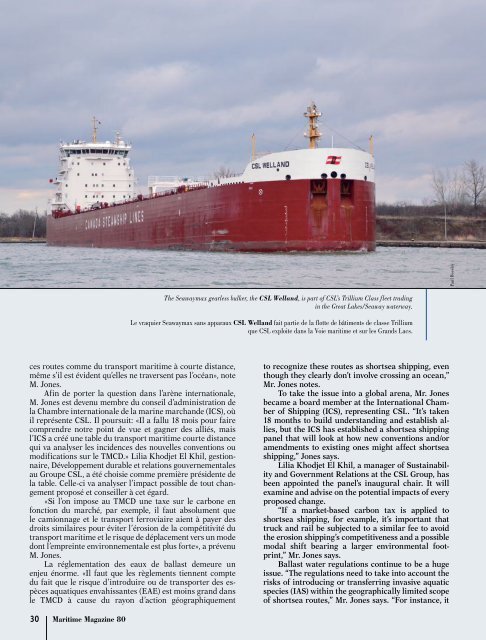You also want an ePaper? Increase the reach of your titles
YUMPU automatically turns print PDFs into web optimized ePapers that Google loves.
Paul Beesley<br />
The Seawaymax gearless bulker, the CSL Welland, is part of CSL’s Trillium Class fleet trading<br />
in the Great Lakes/Seaway waterway.<br />
Le vraquier Seawaymax sans apparaux CSL Welland fait partie de la flotte de bâtiments de classe Trillium<br />
que CSL exploite dans la Voie maritime et sur les Grands Lacs.<br />
ces routes comme du transport maritime à courte distance,<br />
même s’il est évident qu’elles ne traversent pas l’océan», note<br />
M. Jones.<br />
Afin de porter la question dans l’arène internationale,<br />
M. Jones est devenu membre du conseil d’administration de<br />
la Chambre internationale de la marine marchande (ICS), où<br />
il représente CSL. Il poursuit: «Il a fallu 18 mois pour faire<br />
comprendre notre point de vue et gagner des alliés, mais<br />
l’ICS a créé une table du transport maritime courte distance<br />
qui va analyser les incidences des nouvelles conventions ou<br />
modifications sur le TMCD.» Lilia Khodjet El Khil, gestionnaire,<br />
Développement durable et relations gouvernementales<br />
au Groupe CSL, a été choisie comme première présidente de<br />
la table. Celle-ci va analyser l’impact possible de tout changement<br />
proposé et conseiller à cet égard.<br />
«Si l’on impose au TMCD une taxe sur le carbone en<br />
fonction du marché, par exemple, il faut absolument que<br />
le camionnage et le transport ferroviaire aient à payer des<br />
droits similaires pour éviter l’érosion de la compétitivité du<br />
transport maritime et le risque de déplacement vers un mode<br />
dont l’empreinte environnementale est plus forte», a prévenu<br />
M. Jones.<br />
La réglementation des eaux de ballast demeure un<br />
enjeu énorme. «Il faut que les règlements tiennent compte<br />
du fait que le risque d’introduire ou de transporter des espèces<br />
aquatiques envahissantes (EAE) est moins grand dans<br />
le TMCD à cause du rayon d’action géographiquement<br />
to recognize these routes as shortsea shipping, even<br />
though they clearly don’t involve crossing an ocean,”<br />
Mr. Jones notes.<br />
To take the issue into a global arena, Mr. Jones<br />
became a board member at the International Chamber<br />
of Shipping (ICS), representing CSL. “It’s taken<br />
18 months to build understanding and establish allies,<br />
but the ICS has established a shortsea shipping<br />
panel that will look at how new conventions and/or<br />
amendments to existing ones might affect shortsea<br />
shipping,” Jones says.<br />
Lilia Khodjet El Khil, a manager of Sustainability<br />
and Government Relations at the CSL Group, has<br />
been appointed the panel’s inaugural chair. It will<br />
examine and advise on the potential impacts of every<br />
proposed change.<br />
“If a market-based carbon tax is applied to<br />
shortsea shipping, for example, it’s important that<br />
truck and rail be subjected to a similar fee to avoid<br />
the erosion shipping’s competitiveness and a possible<br />
modal shift bearing a larger environmental footprint,”<br />
Mr. Jones says.<br />
Ballast water regulations continue to be a huge<br />
issue. “The regulations need to take into account the<br />
risks of introducing or transferring invasive aquatic<br />
species (IAS) within the geographically limited scope<br />
of shortsea routes,” Mr. Jones says. “For instance, it<br />
30 Maritime Magazine 80


